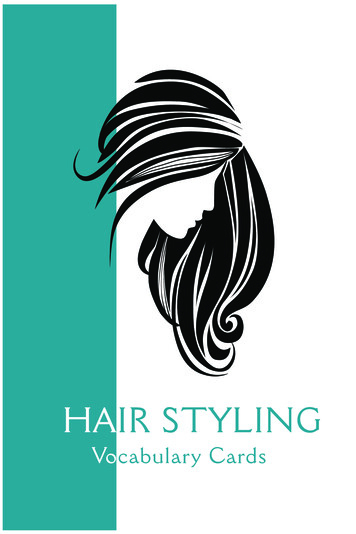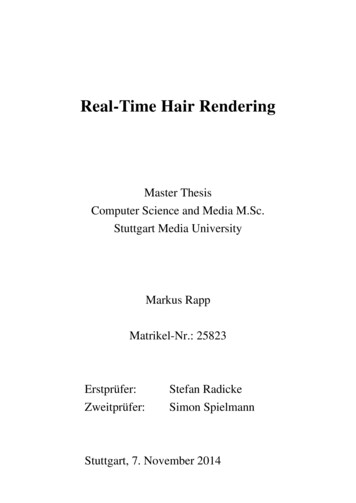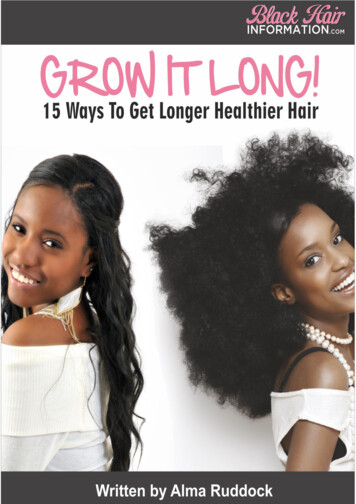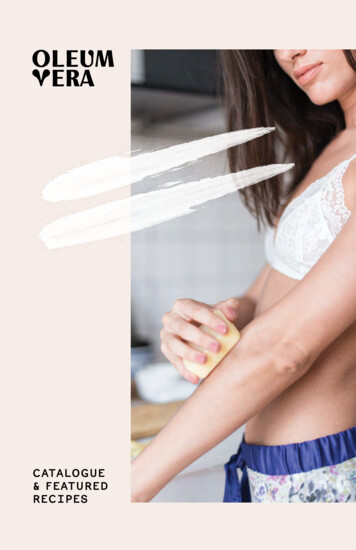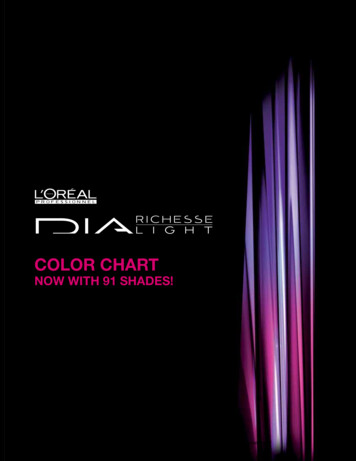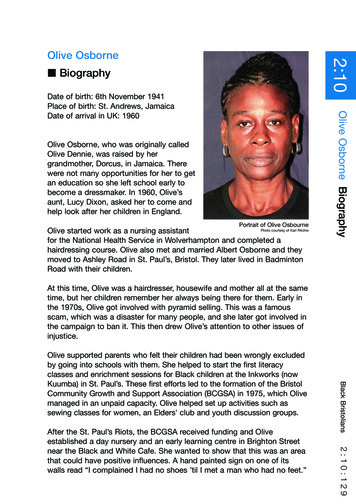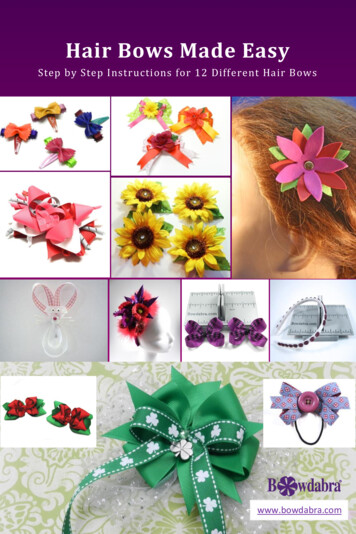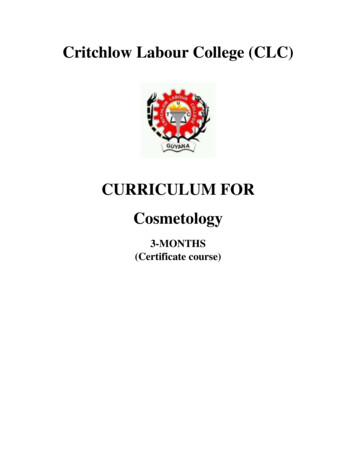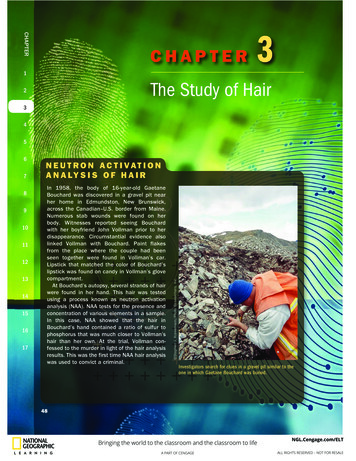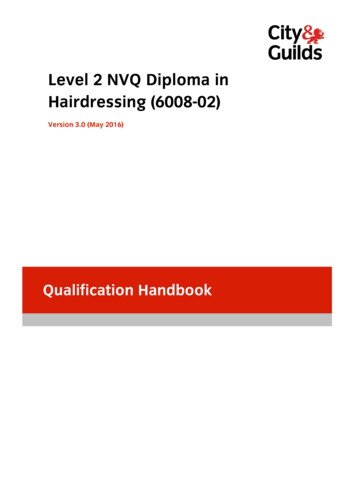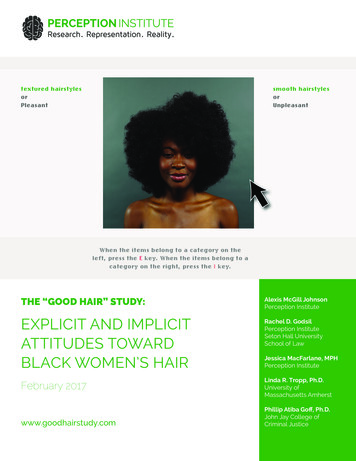
Transcription
textured hairstylesorPleasantsmooth hairstylesorUnpleasantWhen the items belong to a category on theleft, press the E key. When the items belong to acategory on the right, press the I key.THE “GOOD HAIR” STUDY:Alexis McGill JohnsonPerception InstituteEXPLICIT AND IMPLICITATTITUDES TOWARDBLACK WOMEN’S HAIRRachel D. GodsilPerception InstituteSeton Hall UniversitySchool of LawFebruary 2017Linda R. Tropp, Ph.D.University ofMassachusetts Amherstwww.goodhairstudy.comJessica MacFarlane, MPHPerception InstitutePhillip Atiba Goff, Ph.D.John Jay College ofCriminal Justice
THE“GOODHAIR” STUDY:REPORTAUTHORSExplicitandImplicitAttitudes Toward Black Women’s HairAlexis McGill JohnsonExecutive Director, Perception InstituteRachel D. GodsilDirector of Research, Perception InstituteEleanor Bontecou Professor of LawSeton Hall University School of LawJessica MacFarlane, MPHResearch Associate, Perception InstituteLinda R. Tropp, Ph.D.Professor, Department of Psychological and Brain SciencesUniversity of Massachusetts AmherstPhillip Atiba Goff, Ph.D.President, Center for Policing EquityFranklin A. Thomas Professor in Policing EquityJohn Jay College of Criminal JusticePERCEPTION INSTITUTEAlexis McGill Johnson, Executive DirectorRachel D. Godsil, Director of ResearchJessica MacFarlane, Research AssociateResearch AdvisorsJoshua Aronson, New York UniversityEmily Balcetis, New York UniversityMatt Barreto, University of WashingtonDeAngelo Bester, Workers Center for Racial JusticeLudovic Blain, Progressive Era ProjectSandra (Chap) Chapman, Little Red School House & Elizabeth Irwin High SchoolCamille Charles, University of PennsylvaniaNilanjana Dasgupta, University of Massachusetts AmherstJack Glaser, University of California, BerkeleyPhillip Atiba Goff, John Jay College of Criminal JusticeKent Harber, Rutgers University at NewarkDushaw Hockett, SPACEsJerry Kang, University of California, Los Angeles, School of LawJason Okonofua, University of California, Berkeleyjohn a. powell, University of California, BerkeleyL. Song Richardson, University of California, Irvine College of LawLinda R. Tropp, University of Massachusetts AmherstBoard of Directorsjohn a. powell, ChairConnie Cagampang HellerSteven MenendianWe wish to thank the Ford Foundation and the W.K. Kellogg Foundation for their generoussupport for our work, and for furthering a national conversation about equity. A special thank youto SheaMoisture for their inspiring work and contributions to The “Good Hair” Study, and to Dr.Emily Balcetis and New York University’s SPAM Lab for their technical expertise and support ofthe Hair IAT.2
THE “GOOD HAIR” STUDY:Explicit and Implicit Attitudes Toward Black Women’s HairThis report presents preliminary findings fromthe “Good Hair” Study, an original research studyconducted by Perception Institute in 2016 thatexamined attitudes toward black women’s hair andcreated the first Hair Implicit Association Test (HairIAT) to measure implicit bias against textured hair aswell as an online survey to gauge explicit attitudesabout how natural textured hair is perceived. Bias hasbeen shown to correlate with discriminatory behaviorsuch as rejection, avoidance, and abuse. As a result,the concern of this study was to determine the risk ofdiscrimination against black women who wear theirhair naturally.textured hair. Hair bias against natural or textured hair hasa distinct impact on black women for whom textured hairis their “normal.” To be clear, harms linked to racial biasagainst black women have been well documented – in healthcare, policing, education, and the workplace. Increasingly,harms related to racialized gender bias are being examinedto understand why black women experience higher rates ofintimate partner violence, sexual prejudice, and fear isolationmore than their white counterparts.Given what we know about other forms of bias, thisstudy asks whether hair bias affects perceptions of beauty,self-esteem, sense of professionalism, and by extension,workplace opportunities for those whose hairstyles falloutside of the dominant norm. Moreover, if hair bias ispresent, do black women who wear their hair naturallyperceive social stigma as it relates to their own hair choicesvis-à-vis dominant norms? Last, amid a growing naturalhair movement among black women, can the science offerany solutions that can help reduce bias and promote positiveperceptions of natural hair, both for women themselves andamong others who see them?WHAT IS “HAIR BIAS”?In April 2016, SheaMoisture brand launched the provocative“Break the Walls” campaign challenging the beauty and retailindustries to address the aisle ‘segregation’ of hair products byrace. In most stores, hair products catering towards naturaland textured hair are often located in the “ethnic” sectionwhile products designed for those with straight and smoothhair are often located in the “beauty” section. Whetheror not this product placement separation is a function ofintentional store policies or merely ‘de facto’ industry bestpractices, “Break the Walls” charged that routine black haircare product placement away from the ‘beauty’ aisle confers,at minimum, a subliminal message that naturally texturedhair is inferior, less desirable, and less beautiful.Product placement is, of course, but one manifestation ofhow hair standards are normalized within a larger cultureof beauty. Powered by editorial, advertising, fashion, Hollywood, and social media, the beauty industry drives our visualintake daily. Our perceptions stem largely from implicitvisual processes, and as a result, our brains’ repeated exposure to smooth and silky hair linked to beauty, popularity,and wealth creates associations that smooth and silky hair isthe beauty default. Naturally textured hair of black women,by comparison, is notably absent within dominant culturalrepresentation which automatically ‘otherizes’ those naturalimages we do see – at best they are exotic, counter cultural,or trendy; more often than not, they are marginal.Inspired by the questions that Break the Walls raised,Perception Institute set out to explore bias within the beautyindustry – specifically to identify and break the ‘mentalwalls’ of hair bias – negative stereotypes or attitudes thatmanifest unconsciously or consciously, towards natural orHOW DO WE MEASURE EXPLICIT AND IMPLICITHAIR BIAS?Racial bias, or undue prejudice against a racial group, canmanifest as explicit bias, implicit bias, or as both explicit andimplicit bias. Explicit bias refers to the negative attitudes andbeliefs we have about a racial group, deliberately formed ona conscious level. Even in our current era in which explicitbias against some groups, such as Muslims, is consideredacceptable in some cases, openly anti-black racist commentscontinue to trigger widespread condemnation. Researchers,however, are able to measure explicit bias through surveyinstruments and observation.Implicit bias refers to embedded negative stereotypesour brains automatically associate with a particular groupof people. Implicit biases are often inconsistent with ourconscious beliefs. That is to say, we can simultaneously rejectstereotypes and endorse egalitarian values on a conscious leveland also hold negative associations about others or ourselvesunconsciously. Implicit bias can affect our decisions andbehavior toward people of other races and, therefore, leadto differential treatment. Implicit bias is frequently measuredby an Implicit Association Test (IAT) which assesses howstrongly we associate certain concepts – such as race – withstereotypes or attitudes by observing how quickly or slowly1
THE “GOOD HAIR” STUDY:Explicit and Implicit Attitudes Toward Black Women’s HairFor black women, hair is deeply politicized. It has served as akey marker of racial identification, a significant determinantof beauty, and a powerful visual cue for bias (Robinson, 2011;Arogundade, 2000). Tightly coiled hair texture is distinctlytied to blackness and has been a marker of black racial identityfor centuries (Banks, 2000). It is simultaneously linked tobeauty norms (Craig, 2006). When beauty standards aretied inextricably to race, black women experience a specificburden not experienced by either black men or women ofother races (Robinson, 2011; Caldwell, 1991). To be clear,women of other races and ethnicities who have curlyor textured hair may experience pressure to conformto these beauty standards; but black women, in asense, are often pitted against them.For centuries, cultural norms have racialized beauty standards – those with features characteristic of white Europeanancestry are considered more attractive (Robinson, 2011;Craig, 2006; Goff, Thomas & Jackson, 2008). In the UnitedStates, “good hair” is considered to be hair that is wavy orstraight in texture, soft to the touch, has the ability to growlong, and requires minimal intervention by way of treatmentsor products to be considered beautiful. While the “good hair”standard has historical roots, it is perpetuated by pervasivecultural messages that idealize this vision of hair and offertreatments or products to achieve it.Importantly, the culture around black women’s hair isby no means monolithic. Within the past decade, the riseof the “natural hair movement” has been accompanied by aconscious rejection of dominant beauty standards and a celebration of natural hair; more concretely, there has been a 34%decline in the market value of relaxers, products that chemically straighten textured hair, since 2009. The choices blackwomen increasingly are making to wear their hair naturallychallenge traditional norms of what is appropriate, attractive,and professional. As with most choices that defy convention,these efforts to re-define norms have triggered backlash androbust debates around even among “naturalistas” themselves.In addition to natural hair salons – where black womenhave typically organized around hair – communities of“naturalistas” are now online. Through hair blogs, video logs,and other forms of social media, naturalistas coach each otherthrough transitioning (growing out relaxers) and identify thebest products for their hair type. Frustrated by both the lackof consistent knowledge and the multitude of products, naturalistas have crowd-sourced support and debated about hairbias within their own ranks, sharing thoughts on colorismpeople respond in a computer-administered categorizationtask (Greenwald et al., 2009). While not a tool for assessingindividual behavior, the IAT has been shown to be a valuable measure for assessing broad societal attitudes which havethe “potential for discriminatory impacts with very substantial societal significance” (Greenwald, Banaji & Nosek, 2015).Over the past year, studies have provided research supportfor the notion that there is an explicit preference for smoothhair over natural hair (Rudman & McLean, 2016; Woolford etal., 2016); however, researchers have yet to examine implicitbias linked to hair. For the “Good Hair” Study, PerceptionInstitute created the first natural Hair IAT and designedand conducted a national survey of women’s experiences aslinked to hair. Our findings provide an important backdropto recent events related to natural hair – from legal cases onthe perceived professionalism of hairstyles to the appropriateness of hairstyles in school – and have direct implications forfuture research and conversations related to black women’sexperiences. While this preliminary study presents a robustset of findings, Perception Institute will continue to collectdata and analyze as the Hair IAT becomes publicly availableon our website. In the future, Perception will convene andpartner with researchers across disciplines to help shape andfurther these lines of inquiry.WHAT IS “GOOD HAIR”?“It means that a black person has hair that is easyto comb and style. The texture is naturally smoothand sometimes has a loose curl pattern. Easyto manage, maintain and style. Does not need achemical or pressing to style.”“When I hear the term ‘good hair,’ I instantly thinkof racism, because people think that ‘good hairor nice hair’ means women with straight hair orwomen with hair flowing down your back. Youdon’t see women with afros or braids as ‘goodhair.’”“I hate the term, so I refuse to answer this question.”- Selected “Good Hair” Survey responses,August 20162
THE “GOOD HAIR” STUDY:Explicit and Implicit Attitudes Toward Black Women’s Hairperceptions of social stigma and concerns that might affectwomen’s hair maintenance. The research included a nationalsample of black women, white women, black men, and whitemen. Additionally, we obtained a sample of black and whitewomen who are part of an online naturalista hair communityto represent responses from the natural hair movement. Ourresearch questions and hypotheses are organized into fourdistinct categories: explicit bias, social stigma, hair anxiety,and implicit bias.within the natural hair community and bias against tightercurl types, and what natural hair styles are considered “professional.” It is no surprise that beauty industries, both of colorand mainstream, have jumped at the chance to develop products to meet the naturalista communities’ growing demandsand needs, and engage in dialogue and support as well.Yet, despite the growing natural hair movement, recentexisting research suggests that the “good hair” standard maystill have a meaningful effect on the way that black womenare perceived and treated, depending on how they weartheir hair. In 2016, Rudman and McLean measured blackmen and women’s explicit reactions to photos of celebrities (famous black women such as Janet Jackson, Viola Davis,and Solange Knowles) with natural and smooth hairstyles.The study found that overall, the participants preferredsmooth hair, but the black women expressed no preference.Further, other researchers have recognized the potential linkbetween hair and bias. A 2016 study by health researchersfound that black adolescent girls (ages 14-17) might avoidexercise due to concerns about sweat affecting their hair. Infocus groups, the girls reported that they avoided getting wetor sweating during exercise because their straightened hairbecame “nappy” (Woolford et al., 2016). The girls identifiednatural hairstyles as better for exercise but as less attractivethan straightened hair. Similar to the Rudman study, whenshown pictures of celebrities with various hairstyles, the girlsshowed a preference for longer, straighter hair.From the perceptions of professionalism in the workplace,the first impression of a potential employer in a job interview,or the notions of healthy and beauty in every sector – attitudes toward black women’s hair can shape opportunities inthese contexts, and innumerable others. It is critical, therefore, to understand how “hair bias” operates and developsolutions to disrupt and mitigate its effects.RESEARCH QUESTIONS & HYPOTHESESExplicit BiasQ1: On average, what are the explicit attitudes about thebeauty, attractiveness, and professionalism of black women’stextured hair? Does engagement in a naturalista communityaffect explicit attitudes? Do explicit attitudes about texturedhair differ by generation?Hypothesis 1: We expected white women to consider smoothhairstyles on black women more beautiful, more sexy, and moreprofessional compared to textured hairstyles.Hypothesis 2: We expected black women in the national samplewould be neutral in their ratings of beauty and sexiness, but wouldrate smooth hairstyles as more professional than textured hairstyles.Hypothesis 3: We expected members of the naturalista communityto consider textured hairstyles as more beautiful, more sexy, andmore professional than smooth hairstyles.Hypothesis 3b: We expected millennial naturalistas would notexpress explicit preferences for smooth hairstyles.Social StigmaQ2: How do women perceive attitudes toward black women’stextured hair in the US?Hypothesis 4: Regardless of their personal explicit attitudestoward hair, we expected all women would perceive that USattitudes prefer smooth hair over textured hair.THE “GOOD HAIR” STUDYThe “Good Hair” Study aimed to generate and comparedata on implicit and explicit attitudes toward black women’shair. The comparison between these two forms of datahelps explore the racial paradox: the coexistence of positiveegalitarian racial values alongside strong implicit biasesfavoring whiteness. This paradox demonstrates the durabilityof implicit bias despite conscious beliefs, and it is meaningfulbecause implicit bias is a greater predictor of our behaviorthan our conscious values (Greenwald et al., 2009). Inaddition to attitudes, the “Good Hair” Study also exploredHair AnxietyQ3: To what extent do women experience concern or anxietyabout hair maintenance or hold negative feelings about theirhair related to exercise, intimacy, queries to have their hairtouched, etc.?Hypothesis 5: We expected black women overall to report agreater burden of hair anxiety and related impact than whitewomen.3
THE “GOOD HAIR” STUDY:Explicit and Implicit Attitudes Toward Black Women’s Hairthe self-reports are negative and the IAT also illustratesbias, there is cause for even deeper concern about how blackwomen may be treated.Implicit BiasQ4: Do we hold implicit bias related to the texture of blackwomen’s hair?Hypothesis 6: We expected to find implicit bias against blackwomen’s textured hair compared to smooth hair in all samples.Q5: Does implicit bias against textured hair differ amongwomen who are part of an online naturalista community?Hypothesis 7: We expected women involved in an onlinenaturalista community to exhibit lower levels of implicit biasagainst black women’s textured hair as compared to smooth hair.ParticipantsAltogether, 4,163 men and women completed the “GoodHair” Study: 3,475 men and women in the national sample(20% black men, 25% black women, 25% white men, 30%white women) and 688 naturalista women (68% black, 32%white). Everyone in the national sample completed the HairIAT, and 502 women completed the “Good Hair” Survey.All 688 naturalista women completed the Hair IAT and the“Good Hair” Survey.Hair that is textured is typically considered to be “blackhair”; hair that is smooth is considered to be characteristic of“white hair.” For this initial research, we recruited only selfidentified black and white participants and plan to conductfuture studies in which we oversample for other groups, suchas Latinos and Asian-Americans, to understand the specificdimensions of explicit and implicit attitudes within differentcommunities. We note that a small percentage of blackwomen reported having Native American heritage, but thenumbers were not sufficiently large to allow us to reach anyconclusions about these women’s specific experiences.METHODOLOGYProcedurePerception Institute launched the “Good Hair” Study in lateAugust 2016 and collected responses over a two-week period.Perception partnered with a research firm to recruit a largenational sample of black and white women and men throughan online panel. To ensure an oversample of “naturalista”women, we also recruited participants by emailing aninvitation to over 235,000 women in an online natural haircommunity database. We specifically recruited these womenso that we could examine whether the explicit and implicitattitudes of women engaged in an online, pro-natural haircommunity differed from those in the national sample.Discussed in more detail below, the study contained twocomponents: the “Good Hair” Survey and the Hair IAT. The“Good Hair” Survey, which assessed explicit attitudes towardblack women’s hair and experiences related to one’s own hair,was completed by black and white women. The Hair IAT,which assessed implicit attitudes toward black women’s hair,was completed by all participants.We recognized that the “Good Hair” Survey portion, asa self-report measure, can be affected by people’s desire tosee themselves in the best possible light. To that end, wewere interested to see whether the standard egalitarian normstoward race would apply to black women’s natural hair, suchthat when asked expressly to rate concepts such as “beautiful,” “sexy,” and “professional,” people would respondfavorably to natural hair as well as smooth hair. The HairIAT, like all measures of implicit attitudes, gave us a wayto measure bias without having to rely solely on self-reports,and allowed us to compare explicit and implicit attitudes. Ifself-reports demonstrate positive attitudes and the IAT resultsillustrate negative bias, it can highlight a potential disconnect or conflict between values and behavior. If, however,1. The “Good Hair” Survey: Understanding ExplicitAttitudes, Social Stigma, Hair Anxiety, and HairExperiencesThe “Good Hair” Survey was organized into several sectionsto measure women’s explicit attitudes about black women’stextured and smooth hair and to explore the concerns, socialpressures and experiences women have related to their ownhair. In addition to standard race and age demographics,women also reported their hair type – from a range oftextured to smooth hairstyles. Questions related to socialpressures and hair experiences included: hair maintenance(e.g. frequency of hair appointments, costs associated withupkeep); inclination to engage in activities that might requireredoing hair (e.g. exercise, swimming); and activities relatedto interpersonal engagement (e.g. social events, intimacy).To understand explicit attitudes towards textured andsmooth hair on black women, participants were shownimages (see images on p. 5) of the same black woman invarious hairstyles and used Likert scales to rate the beauty,sexiness, and professionalism of the hairstyle depicted inthe photo. Using the same scales, participants were then4
THE “GOOD HAIR” STUDY:Explicit and Implicit Attitudes Toward Black Women’s Hairtextured styles and unpleasant words, indicates implicit biasagainst textured hair.The images for the Hair IAT and the “Good Hair”Survey were created in conjunction with a creative team atSheaMoisture, a subsidiary of Sundial Brands (see imagesbelow). SheaMoisture provided the model with wigs in anumber of typically worn textured (afro, dreadlocks, twistout, braids) and smooth (straight, long curls, short curls, andpixie cut) styles, as well as a makeup and hairstyle artist toshowcase both the model and the hairstyle in the best possiblelight. To ensure the key factor being assessed was hair, thesame model was pictured wearing all of the hairstyles. Thesame images of the woman were used in both the Hair IATand in the “Good Hair” Survey of explicit attitudes.The model in the images was chosen from a set of blackand white models that had been previously validated forattractiveness. The process for validation involved ratingmodel headshots through an online review panel. Attractiveness ratings are typically used for comparison among subjects,and a component of the original study design included evaluating implicit bias toward a white model wearing the sametextured and smooth wigs as the black model. While the findings presented here are related to hair textures on the blackprompted to rate each photo in terms of how most peoplein the US would rate each hairstyle. Including perceptionsof US attitudes allows us to understand perceptions of socialstigma related to textured hair.2. The Hair Implicit Association Test (Hair IAT):Assessing Implicit AttitudesAs part of the “Good Hair” Study, Perception Institutedesigned the first Implicit Association Test (IAT) to assessimplicit attitudes toward black women’s hair: the HairIAT. The IAT (Greenwald et al., 1998) is a computerizedtask in which participants see images of faces from differentidentity groups and are asked to associate the images withpositive and negative words. A faster association betweena group and negative words indicates implicit bias againstthat group. Versions of the IAT have been used in thousandsof research studies to measure implicit bias related to race,gender, sexual orientation, and other aspects of identity. Inthe IAT, images appear along with pleasant (“love,” “peace,”“happy,” “laughter,” and “pleasure”) and unpleasant (“death,”“sickness,” “hatred,” “evil,” and “agony”) words (Greenwaldet al., 1998). For the purposes of this study, a faster associationbetween smooth styles and pleasant words, or betweenI M A G ES O F TEXTUR E D ST Y L ESAfroDreadsTwist-outBraidsLong CurlsShort CurlsPixieI M A G ES O F S M O OTH ST YL ESStraight5
THE “GOOD HAIR” STUDY:Explicit and Implicit Attitudes Toward Black Women’s Hair79% of black millennial (under age 30) naturalistascurrently wear their hair in a natural style. The mostcommon hairstyles are braids (26%), afro (18%), twist-out(12%), and wash-and-go (11%) – only 6.5% of black millennial naturalistas have relaxed hair.model, the validation remains relevant to the methodology,as it allows us to claim that neither race, nor perceptions ofattractiveness, influenced the IAT results. The only variablein the IAT that changes is hair texture.RESULTSDO WOMEN HAVE EXPLICIT BIAS AGAINSTBLACK WOMEN’S TEXTURED HAIR?Who Took the Survey & How do They Wear Their Hair?502 women in the national sample (51% black, 49% white)completed the “Good Hair” Survey. In the national sample,52% of black women currently wear their hair in a naturalstyle, and 48% wear a smooth style. The most commonhairstyles are relaxed (29%), braids (14%), wash-and-go(10%), and afro (10%). 31% of white women currently weartheir hair in a natural style, and 69% wear a smooth style.The most common hairstyles are relaxed (45%), washand-go (25%), loose curls (10%), and smooth waves (9%).688 women in the naturalista community (68% black,32% white) completed the “Good Hair” Survey. 75% ofblack women currently wear their hair in a natural style, and25% wear a smooth style. The most commons hairstyles arebraids (16%), afro (16%), twist-out (15%), and wash-and-go(15%) – only 12% of black women in the naturalista community have relaxed hair. 39% of white women currentlywear their hair in a natural style, and 61% wear a smoothstyle. The most common hairstyles are wash-and-go (30%),relaxed (27%), loose curls (20%), and smooth waves (11%).6 On average, white women show explicit biastoward black women’s textured hair. They rate it asless beautiful, less sexy/attractive, and less professionalthan smooth hair. Black women in the natural hair communityhave significantly more positive attitudes towardtextured hair than other women, including blackwomen in the national sample. Millennial naturalistas have more positiveattitudes toward textured hair than all otherwomen. Black women perceive a level of social stigmaagainst textured hair, and this perception issubstantiated by white women’s devaluation ofnatural hairstyles.
THE “GOOD HAIR” STUDY:Explicit and Implicit Attitudes Toward Black Women’s HairPERSONAL ATTITUDES502 women in the national sample and 688 women fromthe natural hair community rated each hairstyle on a scalefrom 1 to 5 in terms of how beautiful, sexy/attractive, andprofessional they thought it was.We compared the scores of women in the national sampleand natural hair community, by race (national sample: 255black women and 247 white women; natural hair community: 468 black women and 220 white women).We illustrate explicit attitudes toward textured andsmooth hairstyles by showing detailed fi ndings toward theafro (textured) and long waves (smooth). Findings related tothe other six hairstyles are available in an Appendix availableat www.goodhairstudy.com.Table 1 represents the average ratings toward the afro hairstyle, by racial group. The fi ndings demonstrate that blackwomen overall rate the afro significantly more positively oneach of the characteristics than white women (p .001).As Figure 1 illustrates, black naturalistas hold the mostpositive attitudes toward the afro hairstyle – their attitudes aresignificantly more positive than black women in the nationalsample (p .001), as well as white naturalistas (p .001), onratings of beauty, sexy/attractiveness, and professionalism.While their ratings are lower than black women in thenational sample, white naturalistas hold significantly morepositive attitudes toward the afro hairstyle than white womenin the national sample, on all characteristics (p .001).TABLE 1. AVERAGE ATTITUDES TOWARD TEXTURED HAIR –A F ROBlack WomenWhite nal3.42.3FIGURE 1 . E X PLICIT AT T I T U D ES TOWA RD T E X T U RE D HA I R , BY G ROU P – A F RO4.54.33.93.73.53.02.4BeautifulBlack – Naturalista3.12.8Black – National2.3Sexy/AttractiveWhite – NaturalistaWhite – National72.52.1Professional
THE “GOOD HAIR” STUDY:Explicit and Implicit Attitudes Toward Black Women’s HairFIGURE 2. E X PLICIT AT T I T U D ES TOWA RD SMO OT H H A I R , BY G ROU P – LONG C U R LS4.33.63.84.13.6BeautifulBlack – NaturalistaBlack – National4.13.84.04.14.0Sexy/AttractiveWhite – Naturalista4.24.0ProfessionalWhite – Nationalsexy/attractive, but white women in the naturalista samplerate long curls as significantly more professional than whitewomen in the national sample (p .01).Table 2 represents the average ratings toward the long curlshairstyle, by racial group. The fi ndings demonstrate that whitewomen overall rate long curls as significantly more beautifuland sexy/attractive than black women (p .001). Black andwhite women rate long curls as equally professional.As Figure 2 illustrates, black women in the national andnaturalista samples rate long curls as similarly sexy/attractive and professional, but black women in the national samplerate long curls as significantly more beautiful than blackwomen in the naturalista sample (p .05). White womenin the two samples rate long curls as similarly beautiful andTA B LE 2 . AV E RA G E AT T I T U D ES TOWA R D S M O OT H H AIR –LONG C U R LSBeautifulBlack WomenWhite ARE MILLENNIAL
“It means that a black person has hair that is easy to comb and style. The texture is naturally smooth and sometimes has a loose curl pattern. Easy to manage, maintain and style. Does not need a chemical or pressing to style.” “When I hear the term ‘good hair,’ I instantly think of raci
